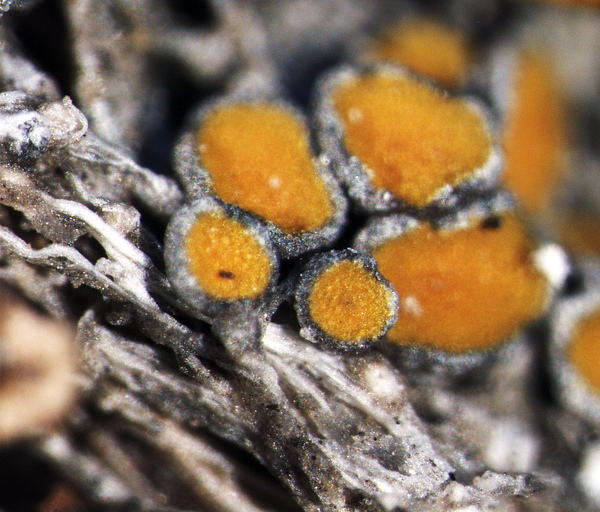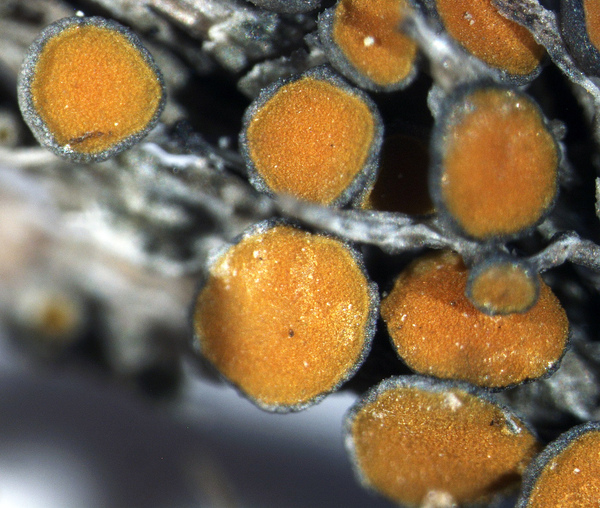Caloplaca stillicidiorum (Vahl) Lynge var. muscorum (A. Massal.)
Provisionally placed here, ICN Art. 36.1b.. Basionym: Callopisma cerinum var. muscorum A. Massal. - Symmicta Lich.: 35, 1855.
Synonyms: Caloplaca cerina var. muscorum (A. Massal.) Jatta; Caloplaca muscorum (A. Massal.) M. Choisy & Werner
Distribution: N - Frl (Tretiach & Hafellner 2000, Hafellner & al. 2008), Ven (Lazzarin 2000b, Nascimbene & Caniglia 2003c), TAA (Nascimbene & al. 2006, Nascimbene 2008b, Hafellner & al. 2012), Lomb (Valcuvia & al. 2003, Dalle Vedove & al. 2004, Ertz & al. 2015), Piem (Morisi & Sereno 1995, Morisi 2005, Matteucci & al. 2013), VA (Piervittori & Isocrono 1999, Valcuvia 2000, Piervittori & al. 2004), Emil (Fariselli & al. 2020), Lig (TSB 33470). C - Tosc (Benesperi 2007, Benesperi & al. 2007), Marc (Nimis & Tretiach 1999), Umb (Genovesi & al. 2002, Ravera & al. 2006), Abr (Nimis & Tretiach 1999, Di Nuzzo & al. 2021, Vallese & al. 2022), Sar. S - Camp (Aprile & al. 2002, 2003b), Bas (Puntillo & al. 2012), Cal (Puntillo 1996), Si (Caniglia & Grillo 2003, Campisi & al. 2020).
Description: Thallus crustose, lead grey to grey, thin to rather thick, more or less continuous or formed by small lobules, pale to dark grey. Apothecia frequent, lecanorine, rounded, sessile, strongly constricted, to almost substipitate, 0.5-1.7 mm across, with a bright orange-red to brown-orange, concave to mostly flat, pruinose or epruinose disc, a poorly evident, somewhat paler proper margin, and a thick, pale to dark grey, sometimes white-pruinose, entire thalline margin. Epithecium orange-brown, K+ red; hymenium colourless, 70-80 μm high; paraphyses branched in upper part, the apical cells 3-6 μm thick; hypothecium colourless. Asci 8-spored, clavate, functionally unitunicate, apically thickened with a broad internal beak, the inner part of apex and external cap I+ blue, Teloschistes-type. Ascospores 2-celled, polarilocular, hyaline, ellipsoid, 11-15(-19) x (4-)6-8(-11) μm, the equatorial thickening (“septum”) 4-7 μm. Photobiont chlorococcoid. Spot tests: thallus K- or K+ faintly violet (in section), C- or C+ violet, KC-, P-; disc of apothecia K+ red. Chemistry: thallus with the Sedifolia-grey pigment; disc of apothecia with parietin (major), fallacinal, emodin, teloschistin and parietinic acid (minor). Note: here I place populations growing on mosses and plant debris, below the subalpine belt and mostly in dry-continental areas, on basic siliceous substrata, with intensely orange apothecial discs. They represent an heterogeneous assemblage of ecotypes whose taxonomy has not been clarified yet (Šoun & al. 2011). See also note on the previous entry.
Growth form: Crustose
Substrata: soil, terricolous mosses, and plant debris
Photobiont: green algae other than Trentepohlia
Reproductive strategy: mainly sexual
Subcontinental: restricted to areas with a dry-subcontinental climate (e.g. dry Alpine valleys, parts of Mediterranean Italy)
Commonnes-rarity: (info)
Alpine belt: absent
Subalpine belt: extremely rare
Oromediterranean belt: absent
Montane belt: extremely rare
Submediterranean belt: very rare
Padanian area: absent
Humid submediterranean belt: extremely rare
Humid mediterranean belt: very rare
Dry mediterranean belt: rare

Predictive model
Herbarium samples
Growth form: Crustose
Substrata: soil, terricolous mosses, and plant debris
Photobiont: green algae other than Trentepohlia
Reproductive strategy: mainly sexual
Subcontinental: restricted to areas with a dry-subcontinental climate (e.g. dry Alpine valleys, parts of Mediterranean Italy)
Commonnes-rarity: (info)
Alpine belt: absent
Subalpine belt: extremely rare
Oromediterranean belt: absent
Montane belt: extremely rare
Submediterranean belt: very rare
Padanian area: absent
Humid submediterranean belt: extremely rare
Humid mediterranean belt: very rare
Dry mediterranean belt: rare

Predictive model
| Herbarium samples |







